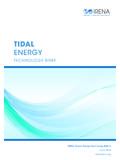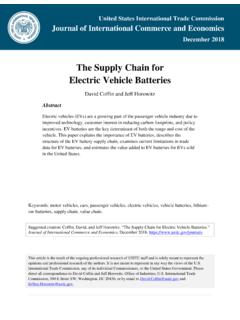Transcription of Electric Vehicles: Technology Brief - IRENA
1 Electric VEHICLESTECHNOLOGY BRIEFF ebruary (c) IRENA 2017 Unless otherwise stated, material in this Brief may be freely used, shared, copied or reproduced, provided that all such material is clearly attributed to IRENA . Material attributed to third parties may be subject to third-party copyright and separate terms of use and web: ISBN 978-92-95111-00-4 ISBN print: ISBN 978-92-9260-000-6 Citation: IRENA (2017), Electric Vehicles: Technology Brief , International Renewable Energy Agency, Abu IRENAThe International Renewable Energy Agency ( IRENA ) is an intergovernmental organisation that supports countries in their transition to a sustainable energy future, and serves as the principal platform for international co-operation, a centre of excellence, and a repository of policy, Technology , resource and financial knowledge on renewable energy.
2 IRENA promotes the widespread adoption and sustainable use of all forms of renewable energy, including bioenergy, geothermal, hydropower, ocean, solar and wind energy, in the pursuit of sustainable development, energy access, energy security and low-carbon economic growth and prosperity. ACKNOWLEDGEMENTS This Brief benefited greatly from reviews by Dolf Gielen and Nicholas Wagner ( IRENA ), Holger Hesse and Peter Keil (Technical University of Munich-ESS) and Bert Witkamp (AVERE), Contributing authors: Lewis M. Fulton (UC Davis), Amr Seleem, Francisco Boshell, Alessandra Salgado and Deger Saygin ( IRENA )For further information or to provide feedback: DisclaimerThis Brief and the material featured herein are provided as is.
3 Neither IRENA nor any of its officials, agents, data or other third-party content providers provides any warranty, including as to the accuracy, completeness, or fitness for a particular purpose or use of such material, or regarding the non-infringe-ment of third-party rights, and they accept no responsibility or liability with regard to the use of this Brief and the material featured information contained herein does not necessarily represent the views of the Members of IRENA . The mention of specific companies or certain projects or products does not imply that they are endorsed or recommended by IRENA in preference to others of a similar nature that are not mentioned. The des-ignations employed and the presentation of material herein do not imply the expression of any opinion whatsoever on the part of IRENA concerning the legal status of any region, country, territory, city or area or of its authorities, or concerning the delimitation of its frontiers or from IRENA image for Policy Makers.
4 2 Highlights .. 5 Technology Status and Performance ..8 Light duty Electric vehicle sales ..12 Sales of other types of Electric vehicles ..15 Costs, markets and consumers ..17 Electric Vehicle Charging and Interactions with Electricity Grids ..20 Electric vehicles and renewable energy deployment ..21 The role of demand-side management ..26 Smart charging ..27 Considering the Future: Electric Vehicle Market Projections ..29 Projections of batteries and electricity demand ..32 EVs and VRE: Combining for low environmental impact ..34 Material requirements ..38 Achieving future EV targets: Technology and policy aspects ..39 Bibliography ..44 Electric Vehicles | Technology Brief2 There are two main types of Electric vehicles (EV): battery Electric vehicles (BEV) that use only batteries for energy storage and must be plugged in to be recharged, and plug-in hybrid Electric vehicles (PHEV) that have both batteries and liquid-fuel storage and refuelling systems.
5 The global stock of Electric vehicles (EVs) reached 1 million during 2015 and passed the 2 million mark in 2016. This rapid rise has been led by China, the US, Japan and several European countries. The uptake of EVs is the result of several factors, including strong technological progress, cost reductions (especially batteries), and policy support, including purchase incentives, driving and parking access advantages, and increased public charging infrastructure availability . Battery Electric vehicles (BEVs) dominated sales over plug-in hybrid Electric vehicles in most countries until 2014, but plug-in hybrid Electric vehicle (PHEV) sales have grown rapidly in the past two years and as of early 2016 were nearly equal to BEV sales worldwide.
6 PHEVs have a considerable range advantage but sacrifice all- Electric driving to achieve this. Despite on-going battery performance improvements and cost reductions, EVs still face potentially important obstacles. New models to be introduced in 2017 and 2018 will be able to drive up to 300 kilometres (km) per recharge, but battery packs up to 60 kilowatt-hour (kWh), even if battery costs drop from their current levels of around USD 350/ kWh to USD 150 kWh in the future, would cost USD 9 000, much more than the drive systems of today s internal combustion engine vehicles. Fuel savings will help pay this back, especially for high-mileage drivers.
7 Battery- Electric vehicles provide zero-vehicle-emissions driving (for both carbon dioxide (CO2)and pollutant emissions), but the upstream CO2 can be substantial, for example in countries with dominant coal power generation. Electric grids must be considerably decarbonised (to 600 grams (g)/ kWh or less) for EVs to have a CO2 advantage relative to similar sized hybrid internal combustion engine (ICE) vehicles. Carbon intensities will need to continuously improve in the future, since hybrids and other ICE vehicles will also become more efficient. EVs also produce no direct air pollution and reduce noise pollution in cities.
8 Insights for Policy MakersElectric Vehicles | Technology Brief3 For the most benefit, EV deployment requires four concurrent strategies: (i) electrification of vehicles; (ii) provision of sufficient charging equipment; (iii) decarbonisation of the electricity generation; and (iv) integration of Electric vehicles into the grid. EV deployment growth would allow a higher share of variable renewable energy (VRE) in the power system, via five areas of interaction: (i) actively using the mobile battery storage system in the vehicle; (ii) use of second-hand batteries in a second life role as stationary battery storage systems; (iii) wide-spread deployment of charging technologies and infrastructure; (iv) evolution in the charging behaviour of EV owners, for example, in which they become comfortable with variable charging rates and times.
9 And (v) provision of other ancillary services from EVs to the grid, such as frequency regulation, shaving peak demand, power support to enhance operation, and reserve capacity to secure the grid by stored energy in its batteries. Electric vehicles create a paradigm shift for both the transport and power sectors, and could support variable renewable power growth through different charging schemes such as time-variable smart charging and vehicle to grid (V2G) electricity supply. Such systems can help support a global doubling of the share of renewable energy by 2030 compared to 2015. The eventual deployment of charging schemes such as smart charging and V2G can support the growth of variable renewable energy and can interplay with information communication Technology (ICT) systems to maximise the technical features and minimise the operation costs using demand-side management tools.
10 REmap a global roadmap from the International Renewable Energy Agency ( IRENA ) to double renewables in the energy mix estimates that a 160 million EVs by 2030 would provide sufficient battery capacity in major markets to support VRE at a large scale. Achieving this stock level, however, will be challenging and will require annual sales growth rates on the order of 30-40% between now and then. To achieve this will probably require that EV markets achieve a tipping point between 2020 and 2025, when they start to rapidly increase market share relative to ICE Vehicles | Technology Brief4 To achieve a tipping point in sales, EVs will likely need to achieve near-parity on a first cost basis with ICE vehicles, and provide sufficient amenities (such as driving range and recharging convenience), such that consumers do not consider them inferior to or comparable to ICEs.















